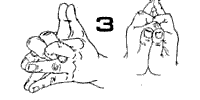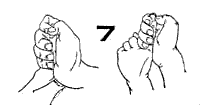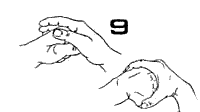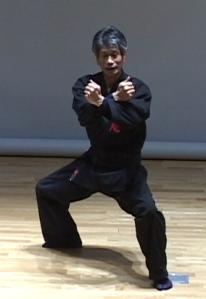Home » Posts tagged 'Myofu An'
Tag Archives: Myofu An
Kuji In
Kuji-Kiri means “Nine symbolic cuts”. It is a technique that belongs to the esoteric Buddhist tradition. From the outside, it seems to consist in drawing nine lines in the form of a grid, then drawing a symbol on the grid. In fact, it is the setting in place of nine energy structures, that once activated, can empower a concept represented by the drawn symbol over the grid. This symbol then interacts with what seems to be reality, and modifies the structure of the universe according to the desired effects. It is the sacred esoteric science of the oriental mage.
Kuji-In is a ritual process that encourages the development of body, mind and spirit. It enhances the nervous system, endocrine system, energy channels of the body, mental abilities, comprehension, quickness of body and mind, and open the doors on great spiritual depth. It involves the combination of many tools to focus all of the practitioner’s attention: hand gesture, spoken words, mental visualization, philosophic contemplation, focus points on the body.
Kuji-in “Nine Syllable Seals,” is a specialized form of Buddhist meditation. It is derived from the Diamond Universe Nine Assemblies mandala of Shingon Buddhism. It is also used by other Buddhist sects, especially in Japan; some Taoists and practitioners of Shinto and Chinese traditional religion; and in folk-magic throughout East Asia.
Technically the word “Kuji-in” refers only to the hand postures (mudra) and their related incantations (mantra). The related practice of making nine cuts–five horizontal and four vertical, alternating–in the air or palm of a hand with the finger or on paper with a brush is known as kuji-kiri, nine syllable cuts. In Japanese folk-magic and onmyodo, the nine cuts are often made over writing or a picture, to gain control of the object named or pictured. Thus, a sailor wishing to be protected from drowning might write them over the kanji for “sea” or “water”. In Kuji-In practice you will be combining those three elements in order to manifest your desires.
The 9 Kuji-In sets with their Japanese titles, associating each with their popular benefits are:
1- RIN – Reinforces the positive aspects of the physical, mental and energetic planes.
2- KYO – Increases the healthy flow of energy, mastery of energy.
3- TOH – Enhances your positive relationship with the universe, resulting in improved harmony and balance.
4- SHA – Develops enhanced healing, regeneration.
5- KAI– Develops foreknowledge, premonition, intuition, feeling.
6- JIN – Increases telepathic ability, communication, knowledgeability.
7- RETSU – Enhances your perception and mastery of space-time dimensions.
8- ZAI – Fosters a relationship with the Elements of creation.
9- ZEN – Results in Enlightenment, completeness, suggestive invisibility.
Mudras of Kuji In
The body is filled with nerves that carry electricity, but it also has circuitry, known as meridians. These meridians are commonly used in traditional Chinese medicine in the application of acupuncture. They are also the base of many massage techniques, since they have many beneficial influences on the body and the mind. Their use normally induces a state of relaxation, making the body prone to recovery. The hand positions, or mudras, crosses and extends the fingers in ways to benefit from these meridians. Even though the meridians travel through the whole of the body, most of them start and end at the fingertips, thus, the hand positions and finger puzzles. When you breathe while concentrating on focus points or acupressure points, it will work on these points in the same way a needle or massage would.
Mantras of Kuji In
The spoken expressions always represent a reference to the philosophy that we keep in mind, yet it is spoken to accelerate the effect of the technique. It is known in auto-suggestions and neural programming that even though we keep a thought in mind, the concept integrates the mental process much faster if it is spoken aloud, since it uses more parts of the brain to speak than if the concept is only mentally contemplated. The words can be spoken in any language, since the important thing is to involve the brain in physical speech. While many practitioners of Japan’s Kuji in appreciate speaking the Japanese kanji pronunciation, some healers and spiritualists prefer the Sanskrit mantra. The concrete affirmations of philosophical expressions are a key component for mental training, as it reinforces the concepts they represent in our mind. While repeatedly reciting a few words that hold a certain meaning, the speech interacts with subconscious parts of our mind to make new connections and render the concept more accessible to our awareness, in our conscious mind.
Mandala
Visualization is an image that we imagine in our mind. Mental visualization is there to help us keep our attention on the technique, hoping to prevent the mind to wander too far astray. Yet, if you start to think about random subjects, do not put pressure on yourself to come back to the visualization, but try to come back in a peaceful and relaxed attitude, calmly resetting the imagery in your mind.
Chakras
When we pay attention to a place in our body for a long enough period of time, the focus point will become relaxed and our awareness of this place will be enhanced. Paying attention to a part of our body will accelerate its healing or regeneration, since our mental attention does lend more neural electricity to the area of attention. This available extra energy is always used in the best possible way by the body. Each of our nine techniques requires us to focus on a specific point in the body, not to heal it but to enhance it. These focus points, specific to each of the nine techniques, are simultaneously a part of the meridians system, nervous system, and endocrine system, associated with an acupressure point, a main nervous center and a gland. When focusing on a point in your body, it should be done in a relaxed attitude. It is not necessary to concentrate with force. Simply pay attention to the focus point and try to feel it. It might take quite a while before you feel any particular sensation at this focus point, and it is not required. The moment you pay attention to a specific place on your body, the technique will be enhanced.
The hand postures are as follows:

(Rin): Hands together, fingers interlocked. The index (sometimes middle) fingers are raised and pressed together.
Jumon is On baishiraman taya sowaka. Mudra is dokko, “seal of the thunderbolt.”

(Pyō): Hands together, pinkies and ring fingers interlocked (often on the inside). Index finger and thumb raised and pressed together, middle fingers cross over index fingers and their tips curl back to touch the thumbs’ tips, the middle-fingers’ nails touching.
Jumon is On isha naya in tara ya sowaka. Mudra is daikongo, “seal of the great thunderbolt.”

(Tō): Hands together, index fingers cross each other to touch opposite ring fingers, middle fingers crossed over them. Ring and pinky fingers are straight. Tips of ring fingers pressed together, tips of pinkies pressed together, but both sets of ring and pinky fingers are separated to form a V shape or bird beak.
Jumon is On jite rashi itara jiba ratanō sowaka. Mudra is “seal of the outer lion.”

(Sha): Hands together, ring fingers cross each other to touch opposite index fingers, middle fingers crossed over them. Index finger, pinky and thumb straight, like American Sign Language “I love you”.
Jumon is On haya baishiraman taya sowaka. Mudra is “seal of the inner lion.”

(Kai): Hands together, fingers interlocked.
Jumon is On nōmaku sanmanda basaradan kan. Mudra is “seal of the outer bonds.”

(Jin): Hands together, fingers interlocked, with the fingertips inside.
Jumon is On aga naya in maya sowaka. Mudra is “seal of the inner bonds.”

(Retsu): Left hand in an upward-pointing fist, index finger raised. Right hand grips index finger, and thumb is pressed onto left index’s nail.
Jumon is On hirota ki shanoga jiba tai sowaka. Mudra is “seal of the wisdom fist,” also known as “seal of the interpenetration of the two realms.”

(Zai): Hands spread out in front, with thumb and index finger touching.
Jumon is On chirichi iba rotaya sowaka. Mudra is “seal of the ring of the sun.”

(Zen): Hands form a circle, thumbs on top and fingers on the bottom, right hand overlapping left up to the knuckles.
Jumon is On a ra ba sha nō sowaka. Mudra is “seal of the hidden form,” also simply called the “meditation mudra.”
The Assassins’ Diary
Chapter One – The Fugitive
Even the way I sit cross-legged on the floor is a lie. Head tilted forward, eyes half shut, I sit on the heal of my left foot. My gaze focused on the candle flame, a saffron mained ballerina twirls around her soot blackened pool. Her azure skirt bellowing, and waining with the slight shift in the currents of my breath. What drives some to madness and others to self-discovery I quiet the internal dialog as I slow my breathing and empty my mind. Images flow thru my mind’s eye without attachment, time slows and then stops. All of my senses fully open and acute as the pit of my stomach and the hair on the back of my neck informs me I am not alone. The image of a train dropping from an opening vortex above my head, along with the whistle of razor sharp steel whipping towards my neck. I wait until the intention pushes me out of the way. The force of malice rolling me backward over my left shoulder as I draw my soul from its home of black lacquered wood and slice up horizontally in one velvet movement.
My attacker crumples as the katana cleanly melts a path through muscle, bone, and tendon. Mouth open his head lays in the spreading ruby pool even as the ring of steel upon hardwood floor echoes. Death has come once again and left satisfying his hunger with his servant rather than his target. My tiny dancer has also left, extinguished by a drop of crimson splashed upon her skirt. I raise and perform chiburi, the ritual cut removing gore from my brilliantly polished katana automatically. As practiced thousands of times, my soul returns home to be cleaned properly later, while reflecting on this last attempt upon my life.
For the last three years, I have survived attempt upon attempt for retribution of an offense against a man I have never met. His daughter, my lover the cause for my status as fugitive. Thirteen times, I have dodged death with one cut and one kill as the hunter has become the hunted. I know that in order to end this chase I must kill once more. I must extinguish the flame of a living legend, the teacher of my teacher. One of the most respected and greatest masters of Kobujutsu, ancient warrior arts, must have the veil of life’s illusion removed from his eyes. In order to explain my current dilemma and enigma I must start at the beginning. My recruitment by the Cadre, training in the ancient craft of the shadow warrior assassin, and my work killing people for political and financial gain. I am a civil servant working in the darkness delivering a message with no return address.
Kamae
Kamae is not just a posture to move from or to but more importantly a manifestation of mental and spiritual power. There is intention and energy that is projected naturally. Part of the process of mastering Kamae is first to feel this natural projection, then to intensify and finally to hide or give a false sense. It is extremely dangerous in the world of real martial arts for your opponent to immediately and clearly see what your intentions are. For a trained fighter this is what exposes the weak points. To understand each Kamae takes time to settle into the frame, to not only study the posture and the way your body feels but to reflect on the reason we move into and out of each frame while practicing Kata. When first learning Kamae I would hold the posture in upwards of 12 to 15 minutes in order feel the weakness in my body. I studied what muscles were being strained, how was my balance and what corrections did I need to make to my posture to correct poor balance. Could I move easily into another Kamae, how must I shift the weight in order to move smoothly? These are the questions you must ask yourself first. After 30 minutes you are able to perceive natural intention. Before deep understanding of Kamae, your martial arts will have no spirit.


